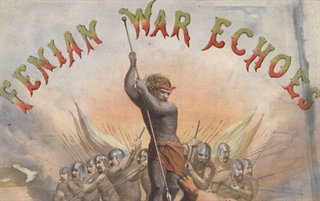 One of the many fun parts of my job as director at the Ward Irish Music Archives is diving down the rabbit hole of research that a certain collection or item inspires. When this gorgeous sheet music cover of "Shan Van Vocht" came across my desk, I was drawn into the history of the Fenians right at the 150th anniversary of their failed Canadian raids of June 1, 1866.
One of the many fun parts of my job as director at the Ward Irish Music Archives is diving down the rabbit hole of research that a certain collection or item inspires. When this gorgeous sheet music cover of "Shan Van Vocht" came across my desk, I was drawn into the history of the Fenians right at the 150th anniversary of their failed Canadian raids of June 1, 1866.
“Fenian” is a term well known to students of Irish history, a term associated with rebelry in Ireland’s lengthy quest for independence. If there was a year that is most associated with the Fenians it would be 1866. This was the year they thought would be their greatest triumph, but instead received their ultimate demise. Yet the term has lived on with great pride among Irish republicans, although “Fenian” holds a different connotation to Canadians.
The Rising of 1848 and American Origins
The Fenians rose from the ashes of the 1848 Young Irelander Rebellion in Ireland. Shocked by the devastation of the great potato famine in the 1840s, An Gorta Mór, and the rise of other revolutions in Europe, The Young Irelanders formed to rebel against English rule in Ireland. The 1848 rebellion was small and failed, and the leaders were forced to leave Ireland. After a brief stay in Europe, one of the leaders, James Stephens, fled to the U.S.
Stephens formed the Fenian Brotherhood in 1858. Taking the name from the Irish mythical cycle of the hero Finn MacCool, its goal was an armed rebellion in Ireland to remove British rule. Later that year Stephens returned to Ireland and formed the Irish counterpart to the Fenians, The Irish Republican Brotherhood.
The timing was fortuitous as an enormous number of Irish emigrated to the U.S. during the famines, and America was entering the Civil War. The Fenians felt they would exit the American civil war with a well-trained Irish and Irish American army that could finally gain Ireland’s independence.
Fenian Raids of Canada
Instead of a full scale rebellion in Ireland, The Fenian Brotherhood devised a plan to invade Canada and hold areas hostage until Britain gave Ireland its independence. There were five raids on Canada and all failed. The most notable of these raids was the Battle of Ridgeway which took place on June 1, 1866.
The failed Fenian raids in Canada had many effects. They created Canadian skepticism towards America’s intentions as a neighbor. The raids were one of the reasons that one year later, in 1867, Canadian provinces unified into the Confederation of Canada. In fact, Thomas D’Arcy McGee, a staunch supporter of Canadian confederation and himself a part of the Young Ireland movement, was assassinated in 1868 by a suspected Fenian plot.
The 1866 raids in Canada divided The Fenians. American support for the cause was now diminished. In Ireland the Irish Republican Brotherhood chose to create a new partner in the U.S. with the creation of Clan na Gael thus more or less ending the Fenians role in politics. They formally disbanded in 1880.
At the Ward Irish Music Archives we have four pieces of sheet music about the Fenian movement. Significantly three were published in 1866, the year of the Fenian raids.
"Shan Van Vocht"